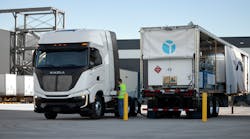Just like passenger cars, commercial vehicles are in the midst of technological, regulatory and maintenance transformations that will have lasting effects on the marketplace. Some of these changes will create new opportunities, while others may necessitate creative solutions from fleets.
Following up on interviews with executives from MERA member companies, it became clear that – with the right planning – fleets can utilize resources already in place to help cut costs, better manage technician repair times and decrease the downtime required for vehicles in a service bay. These solutions, which MERA sees as trending upward over the next five years, will be especially helpful if the economy underperforms or fleets find themselves struggling to cut expenses.
Commercial vehicle ownership periods lengthening
One trend that MERA members see on the horizon is that as the demand for new OE commercial vehicles will slow down beyond 2019 as both fleets and independent operators hold on to aging vehicles longer. With more miles on fleet vehicles before new replacement, the need to perform regular maintenance and repairs will increase.
This normally would cause concern for a fleet, because not only does the vehicle now require an investment in replacement parts, it also is no longer capable of generating revenue each day it remains out of service.
At this point, fleets will have a decision to make in terms of what types of parts to put into a vehicle repair. By weighing the expected quality of a part against the cost of various replacement options such as new, remanufactured, rebuilt or used, a fleet can determine a benefit-cost ratio for the value of each solution.
“A fleet manager or owner-operator will always look for the most cost-effective solution that meets their expectation of quality,” says Henry Foxx, Bendix Commercial Vehicle Systems’ director of remanufactured products. “As fleet vehicles age, the value of a replacement part to the end user is increased when it costs less but performs the same as the original part.”
It is important for fleets to keep in mind that only two replacement part options, new and remanufactured, go through an extensive standardized industrial process to produce parts that are fully warrantied.
Whether through the OE or independent aftermarket channel, remanufactured parts are priced up to 30 percent less, on average, when compared to new. This benefits fleets by reducing the money spent on replacement parts. The ability to manage expenses, without compromising quality, will become crucial to fleets as vehicles age.
Part replacement risks placed on suppliers
As more maintenance is required, fleets will increasingly turn to parts suppliers who can offer the peace of mind that should any fault arise with a repair, a replacement under warranty will be handled expediently to reduce downtime.
In response, as the need to get quality parts in the hands of technicians continues to rise in the coming years, both OE dealer networks and independent channels are expanding to meet fleet demands. Since new and remanufactured parts are mass-produced, off-the-shelf solutions compared to rebuilt or used products, by servicing a vehicle with a new or remanufactured part, the responsibility to maintain a sufficient supply for warranty claims will correspondingly shift to the parts manufacturer.
“At Volvo, we have authorized repair centers across North America,” says Sherman Williams, director of remanufacturing and proprietary product development at Volvo Trucks North America. “This allows us to meet the service needs and available parts demand of fleets across the country. By delivering replacements rapidly, the risk to the end-user in terms of downtime is minimized.”
Increasing operating costs due to regulation
MERA members also see material costs for both new manufacturing and remanufacturing increasing as state and federal government regulations continue to implement “better brake laws,” restricting the use of certain materials, along with mandates for alternative powertrain systems in vehicles to meet emissions goals.
These, and other regulations, could raise maintenance costs for fleets as next-generation materials are used in place of traditional materials and processes. Additionally, servicing these advanced systems will require additional technician training and experience, which could ultimately be passed along to the fleet.
However, Jay Pagano, general manager at Global Parts Network, has a silver lining for fleet operators.
“Costs for certain repairs may actually be reduced over time as more commercial vehicles come standard with air disc brakes and lightweight braking systems, such as those being produced by Bendix, Haldex, Meritor and others,” he says. “It will be interesting to see how these newer technologies impact the market.”
Additionally, MERA members believe regulations or laws regarding technology such as Advanced Driver Assistance Systems (ADAS), automated driving and platooning systems may impact maintenance costs, should these items become standardized or required for commercial vehicles in the coming years.
Technician shortage and service time allocation
Lastly, MERA members project, like many other groups, a shortage of skilled service technicians. However, by implementing a repair program that utilizes different part options with high availability, a technician of lower training level can rapidly install a part via swing-exchange, instead of repairing or rebuilding a part at the service center.
This allows technicians to move efficiently from one service to the next, without sacrificing the quality of the repair or attention to detail. Fleets can then better assign technician schedules and produce the same amount of work with less labor.
John Chalifoux has served as the president and chief operating officer of MERA – The Association for Sustainable Manufacturing – since its inception in January 2011. MERA is recognized internationally as the organization for companies that view remanufacturing and similar forms of sustainable manufacturing as a core competency.


